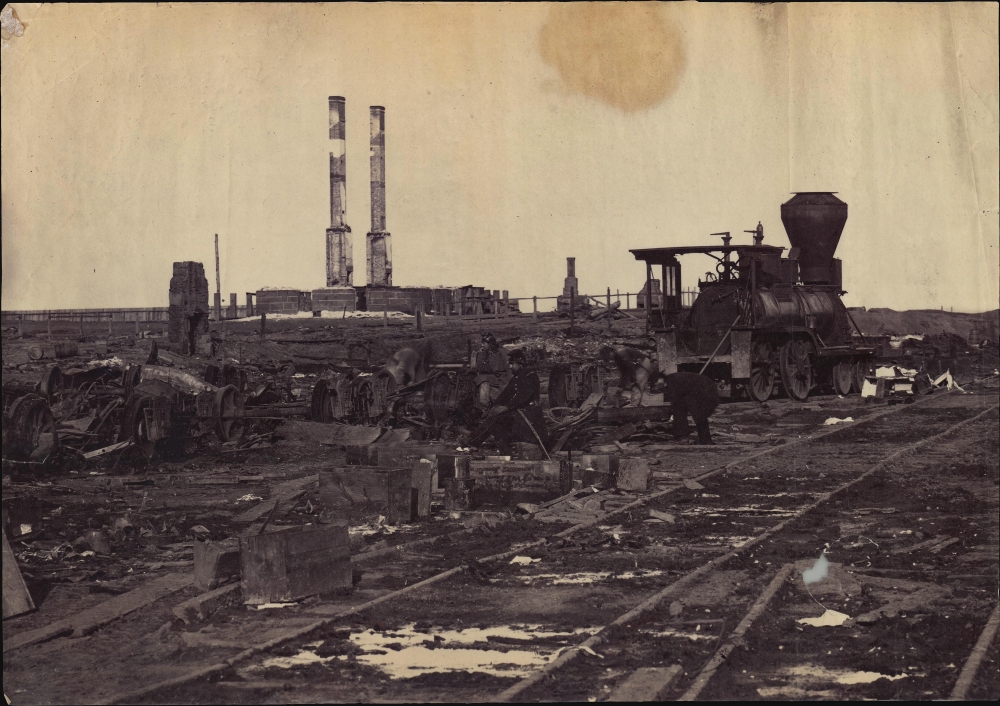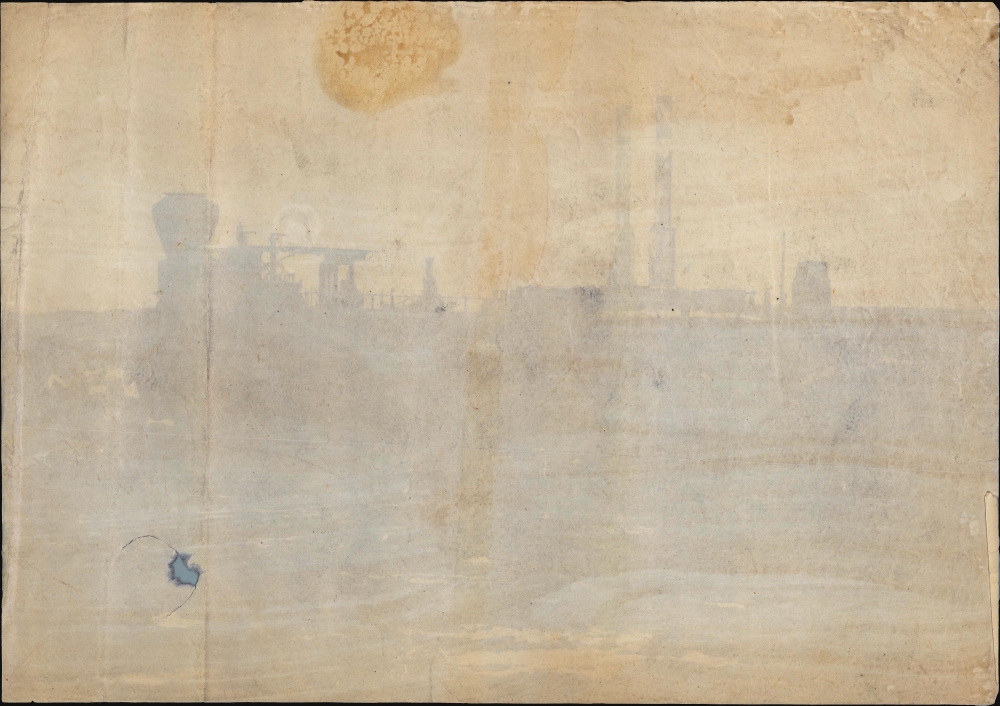This item has been sold, but you can get on the Waitlist to be notified if another example becomes available.
1862 Brady and Co. Albumen Photograph of Manassas Junction, Virginia, After Confederate Evacuation
ManassasJunctionBurntTrain-brady-1862
Title
1862 (undated) 9.5 x 13.5 in (24.13 x 34.29 cm)
Description
A Closer Look
The photograph’s focal point is a burnt out locomotive shell, with only the wheels and other detritus remaining from the rest of the rolling stock. Rails appear in the foreground, underscoring that at least two lines converged at this junction. Two Union soldiers appear among the destruction, with a third (blurred by motion) visible in front of the locomotive. His non-military hat leads us to think he is a civilian, possibly one of the photographers. Chimneys stand in the background atop the brick foundation of one of the Confederate warehouses built to supply the army.The March 1862 Confederate Retreat from Manassas Junction
After the Confederate victory at the July 1861 First Battle of Manassas, Confederate armies occupying northern Virginia formed a defensive position from Leesburg to the Potomac River. They established encampments and outposts around Centreville and Manassas Junction, with the combined armies of the Potomac and Shenandoah under the command of General Joseph Johnston. In early 1862, as the possibility of a Confederate assault on Washington, D.C. faded, Johnston became convinced he needed a more defensible position. His army was spread across northern Virginia and had not yet morphed into a professional fighting force. His soldiers carried excessive personal baggage and the army was encumbered by a large civilian train, including families, servants, and slaves. To further complicate matters, Confederate quartermasters built enormous supply warehouses near Manassas Junction. While conveniently close to the army, these were also dangerously close to the front line and well within the reach of a swift Union advance.Johnston conveyed his concerns to Confederate President Jefferson Davis in mid-February 1862, but the two apparently did not understand one another. Johnston left the meeting believing that he could 'fall back as soon as practicable', while Davis did not believe the evacuation of Manassas Junction necessary if reinforcements could be provided. Johnston also stopped communicating with Richmond (the Confederate capital), fearing Union spies. Confronted with an ever-expanding Union Army (nearing 100,00 men to Johnston's 40,000), Johnston began making preparations to evacuate Manassas.
Johnston ordered the evacuation of Manassas Junction on March 5, 1862. In total over 3 million pounds of supplies had been accumulated around Manassas Junction. He ordered the warehouses opened, allowing his men could take whatever they could carry. A massive warehouse at Chapman's Mill with over a million pounds of meat was opened to local farmers to take free food. Everything remaining was burned. The Confederates then destroyed the military railroad they had previously constructed (the first ever military railroad) from Manassas Junction to Centreville. The evacuation took four days, but successfully repositioned Johnston’s army safely behind the Rappahannock River. The Union Army entered Centerville on March 10. Because of Johnston's lack of communication and destruction of so many needed supplies, he lost the confidence of Davis and the Confederate government, prompting the elevation of General Robert E. Lee.
Mathew Brady and Civil War Photography
Mathew Brady (c. 1822-1824 - January 15, 1896) was a successful portraitist and photographer at the beginning of the American Civil War (1861 - 1865). At the outbreak of the war, he advertised his services to take portraits of soldiers leaving to fight, making popular cartes de visites. Soon, he realized that the new technology could be used to document the war.Brady's effort, into which he invested at least $100,000 of his own money, has dubbed him the 'first photojournalist'. He developed mobile dark rooms and other photographic equipment to make this undertaking possible. Brady hired a cadre over 20 photographers, developers, and other workers to assist in this task. Many of Brady's photographers, including Alexander Gardner, Timothy O'Sullivan, George Barnard, Egbert Guy Fowx, and Thomas C. Roche, took iconic photographs that resonate to this day. However, Brady took and copyrighted most of the images under his own name as 'Brady and Company'. This caused ruptures with some photographers (most notably the extremely talented Gardner), which had repercussions for the rest of his life. The 'myth' of Brady's photographic prowess overshadowed any successes by other photographers, whether they worked for him or not. To this day most Civil War photography is attributed to Brady. Some have suggested, due to his failing eyesight, that he acted more as a director, making few of the field photographs himself. Historians generally see Brady's role as organizer, financier, advertiser, and entrepreneur. His insistence on using the 'Brady and Company' imprint on all images without giving credit to the individual photographers has complicated his legacy and made identifying specific photographers under the company umbrella challenging - if not impossible.
Publication History and Census
This photo has been attributed to Brady and Company, although unfortunately the historical record does not provide the photographer's identity. We note a single cataloged example of this photograph, located at the Library of Congress. The original glass negative has been lost.Cartographer
Mathew B. Brady (c. 1822-1824 - January 15, 1896) was an American photographer. Brady's early life is a mystery. In his later years, just before his death, Brady claimed to reporters that he had been born in Warren County, New York, near Lake George, and that he was the youngest of three children to Irish immigrant parents. However, before and during the Civil War, Brady claimed in official documents to have been born in Ireland. Brady moved to Saratoga, New York, at the age of 16, and began studying painting with William Page, a portraitist. Page and Brady moved to Albany, then New York City, in 1839, and Brady continued studying with Page as well as Samuel Morse, Page's former teacher. That year Morse had studied with Louis Jacques Daguerre (the inventor of the daguerreotype - an early form of photography) in France. Morse became an enthusiastic proponent of daguerreotypes and began promoting the new technology in New York. Brady's early involvement with Morse's new venture was limited to making leather cases for the daguerreotypes. But, when Morse opened a studio and began teaching classes on the new method, Brady eagerly became one of his first students. Brady opened his own studio in 1844 and the following year was exhibiting portraits of such luminaries as Edgar Allen Poe and Senator Daniel Webster. He opened another studio in Washington, D.C. in 1849, but had to abandon it in 1850 after falling out with his landlord. Brady hired Alexander Gardner in 1856. In 1858, when Brady decided to open a D.C. studio, he made Gardner the manager. At the beginning of the Civil War, Brady marketed his successful cartes de visite to departing soldiers and their families, but his interest soon turned to documenting the war itself. Brady petitioned General Winfield Scott and President Lincoln to allow his photographers to travel to battle sites. Lincoln approved his request, although he stated that Brady would have to finance everything himself. To do so, Brady developed a mobile photography studio and darkroom and employed over twenty men, each of whom had their own traveling dark room. Among his employees were Alexander Gardner and Timothy O'Sullivan. Brady's assistants took thousands of photographs of Civil War scenes, from the First Battle of Bull Run to Appomattox Court House. After the war, interest in Brady's photographs declined exponentially, leaving him in dire straits. Brady spent over $100,000 (about $1.878 million in 2022) during the war which resulted in the creation of over 10,000 glass negatives. Brady expected that the U.S. government would buy the negatives after the war, but, despite the recommendation of the Joint Committee on the Library, Congress did not purchase Brady's work. This forced Brady to sell his Washington studio in 1870 and later his New York studio, and eventually file for bankruptcy. He died penniless in the charity ward of New York City's Presbyterian Hospital. More by this mapmaker...




